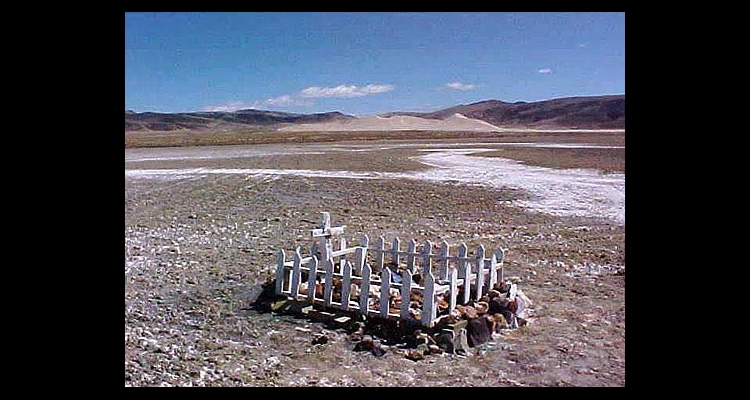Highway 50: LeBeau Graves
Approximately twenty-five miles east of Fallon, Nevada, U.S. Highway 50 crosses a barren, alkali-crusted, dry lake bed known as the Four Mile Flat. Along this windblown stretch of the Loneliest Highway in America, a hundred or so yards north toward the wavering dunes of Sand Mountain, is a small, weathered looking picket fence that surrounds a five-foot-square pile of rocks topped by a whitewashed wooden cross. Local folklore maintains this is either gravesite or a memorial. For decades, locals have periodically tended the forlorn place known only as the LeBeau Grave Site, and local and national publications have debated its origin. The facts, however, are scarce.
For many years a cross attached to the fence bore the inscription: "Two pioneer children. Known only to God." Sometime later, a newer marker appeared at the site that was inscribed with the year 1865 and the names of three (not two) sisters: Jennie LeBeau (9), Louise LeBeau (6), and Emma LeBeau (3). These girls, according to widely believed stories, died of diphtheria while traveling with a wagon train through the area along the Old Simpson Trail. Others, including former U.S. Fish and Wildlife Service refuge field supervisor, Johnnie Johnson, claimed to have had evidence that a fourth child, a young boy, was also buried at the site. Another inscription was added: "Wilson Turner 3yrs. 1864."
Over the years, a few locals have attempted to maintain the graves, repairing and replacing the wooden fence and crosses. Even so, the appearance of the grave site is constantly changing. Flowers, children's toys, dolls, and even articles of clothing are continually added by caring visitors. And questions linger. Who, if anyone, is really buried at the site? When did the burials occur? Among the plaques added to the site over the years is one that provides as good an epitaph as any: "Dedicated to the memory of the hundreds of men, women and children, and thousands of animals that perished on the Old Simpson Trail to California 1846 to the 1880s."
Article Locations
Related Articles
None at this time.
Further Reading
None at this time.
